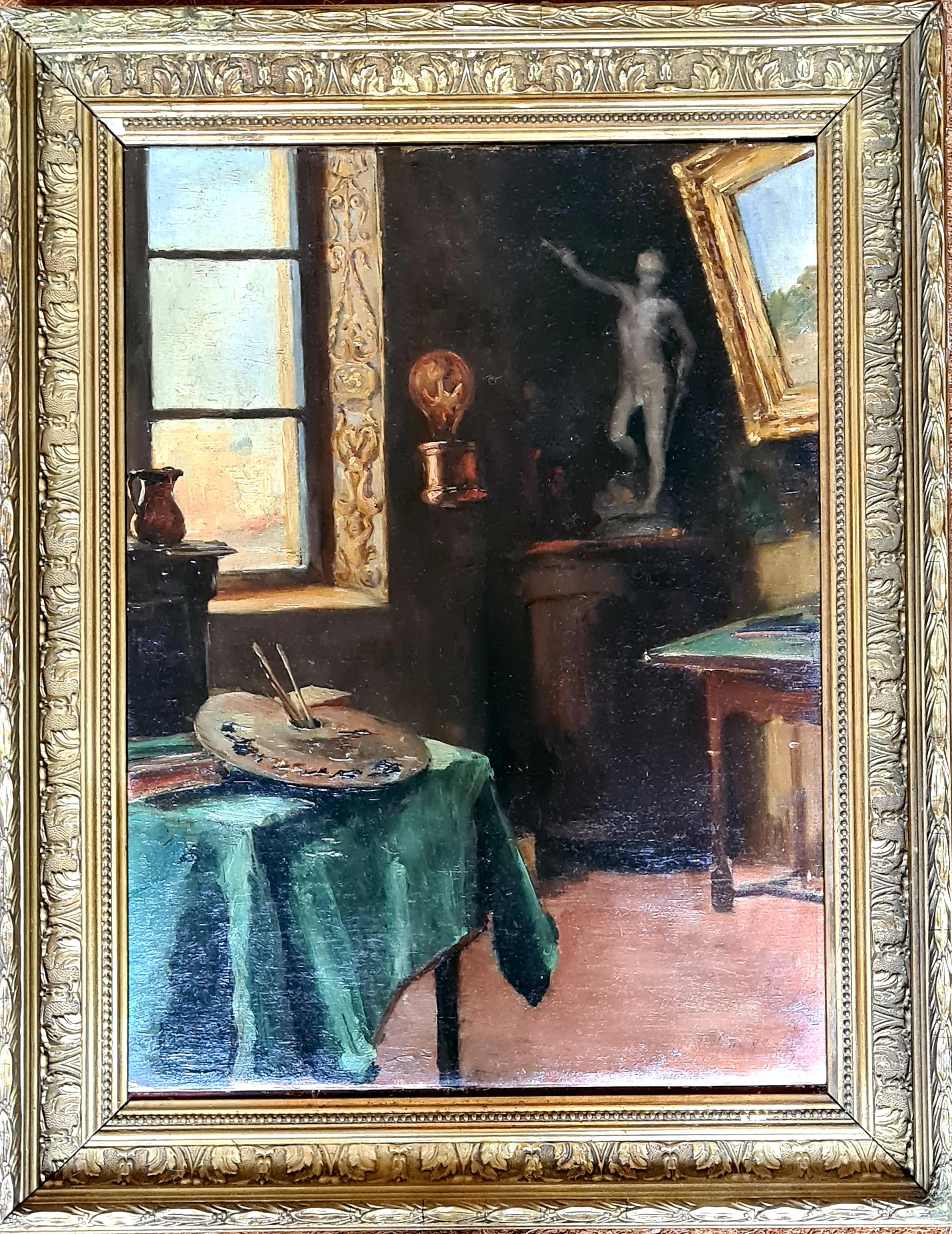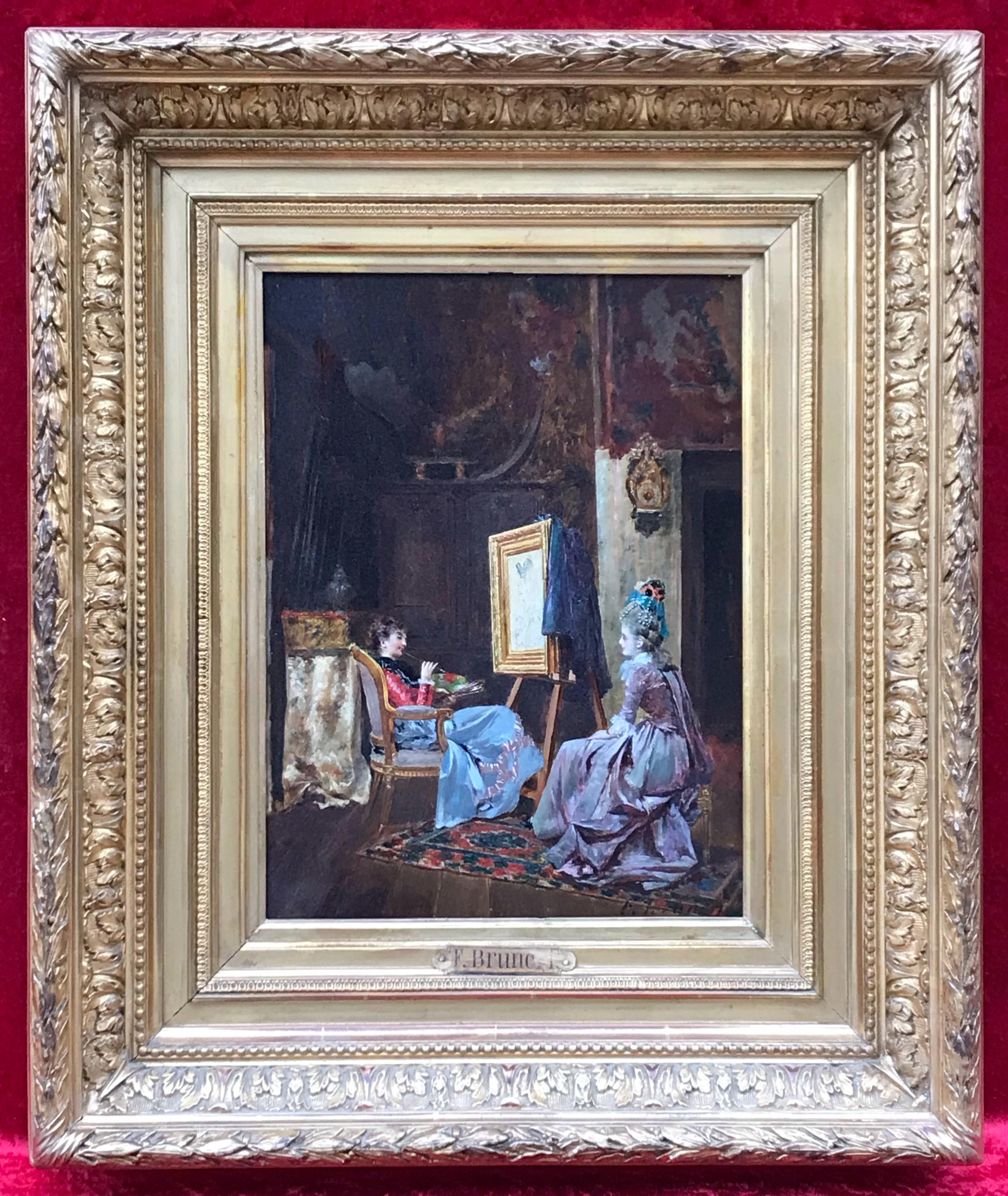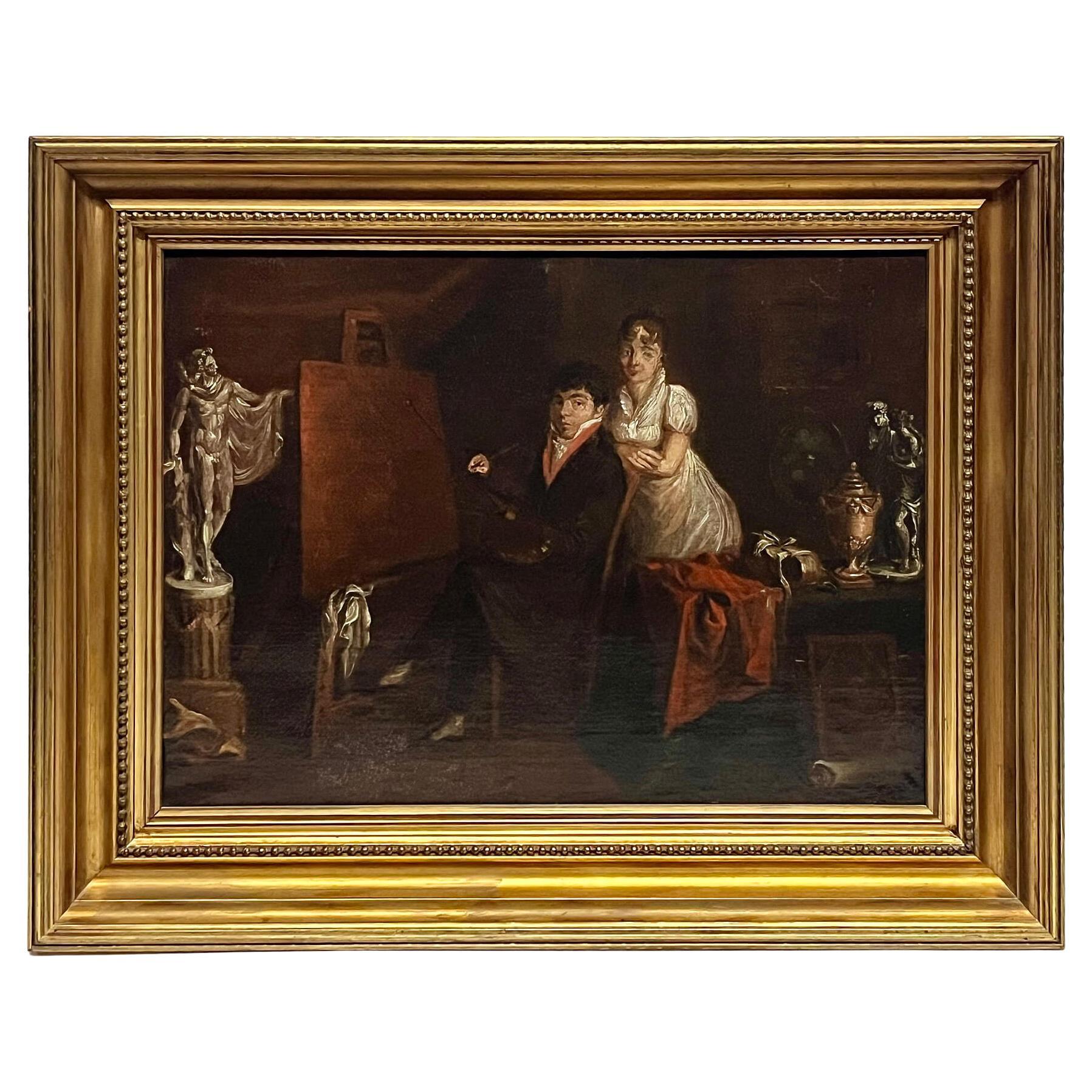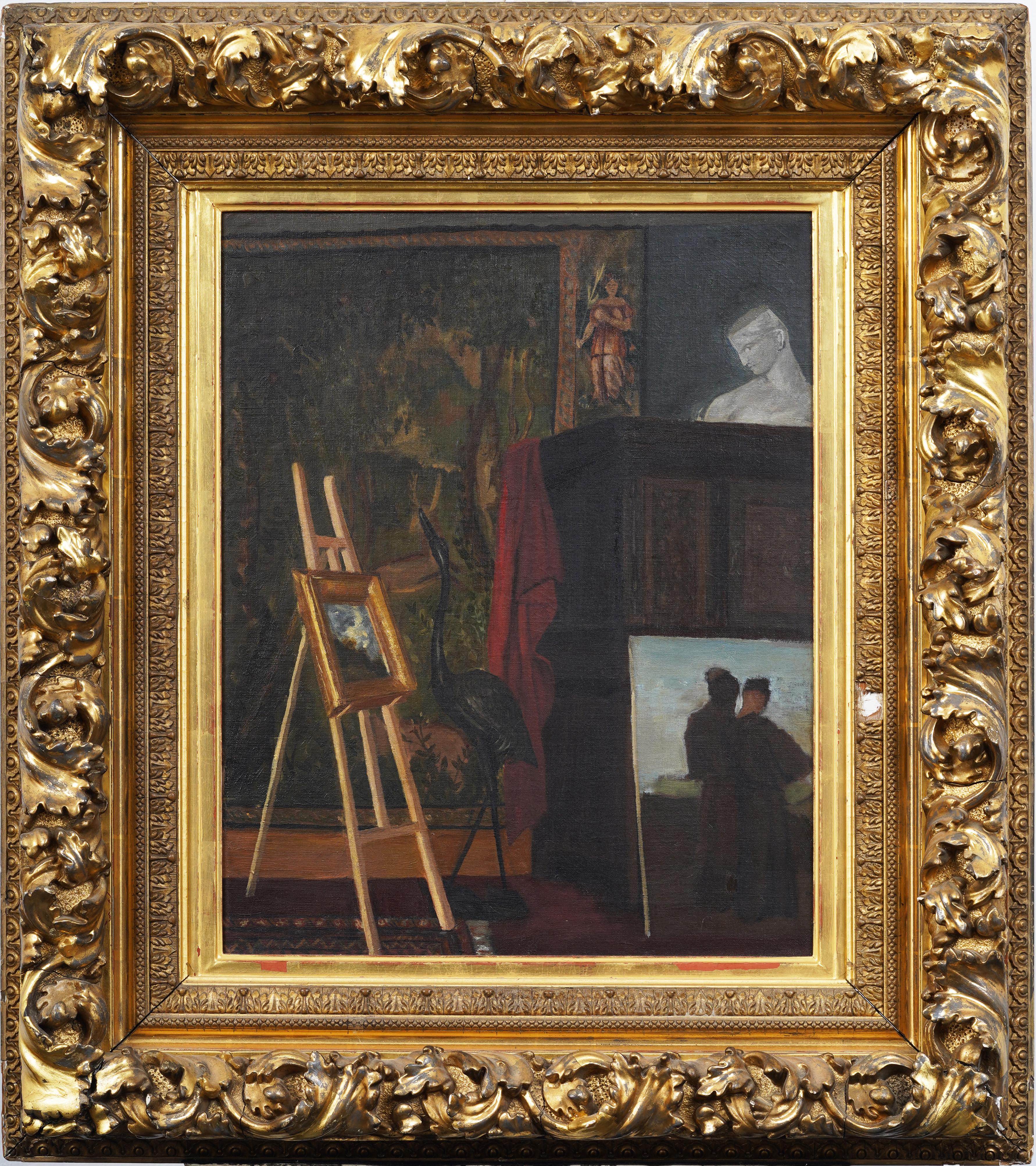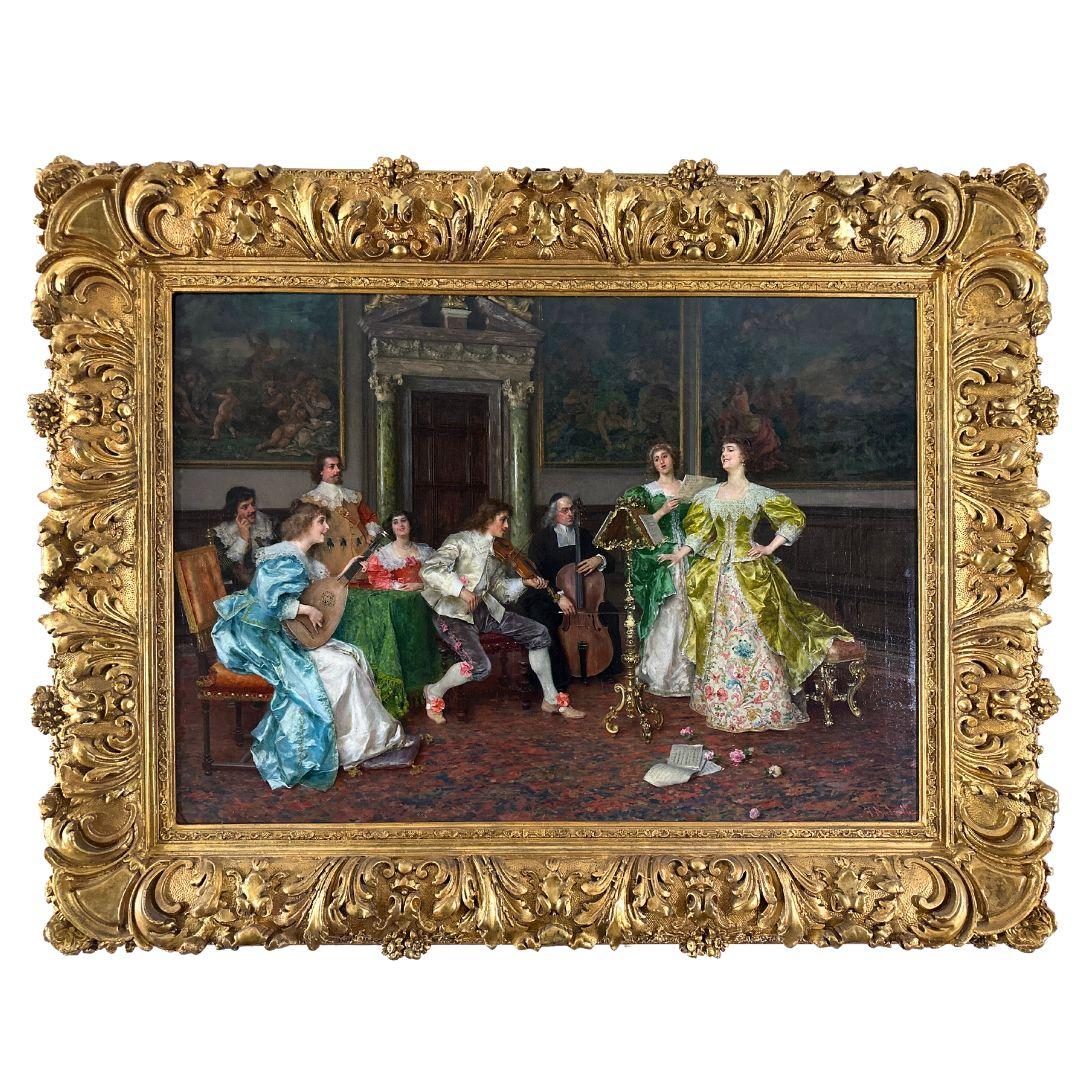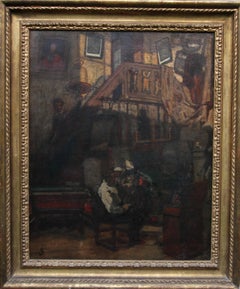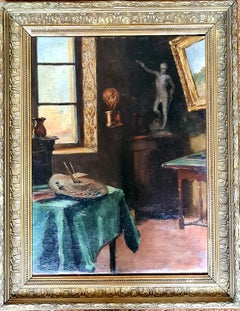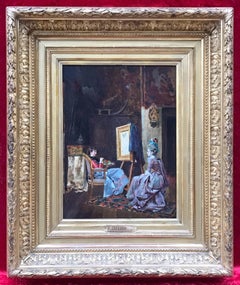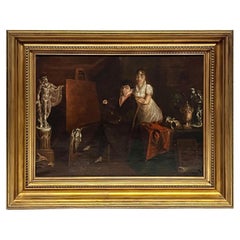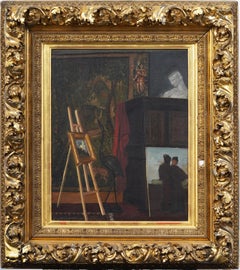Items Similar to Artist in his Studio - French 19th century art figurative interior oil painting
Want more images or videos?
Request additional images or videos from the seller
1 of 14
Adolphe MonticelliArtist in his Studio - French 19th century art figurative interior oil paintingCirca 1870
Circa 1870
$9,872.31
$12,340.3820% Off
£7,200
£9,00020% Off
€8,397.21
€10,496.5120% Off
CA$13,518.57
CA$16,898.2120% Off
A$15,030.81
A$18,788.5120% Off
CHF 7,848.26
CHF 9,810.3220% Off
MX$182,961.51
MX$228,701.8920% Off
NOK 100,140.35
NOK 125,175.4320% Off
SEK 93,826.72
SEK 117,283.4020% Off
DKK 62,669.90
DKK 78,337.3820% Off
Shipping
Retrieving quote...The 1stDibs Promise:
Authenticity Guarantee,
Money-Back Guarantee,
24-Hour Cancellation
About the Item
This lovely French 19th century figurative Impressionist oil painting is by Adolphe Monticelli. Painted circa 1870 the painting depicts a group of seven figures amusing themselves in the arts. The key figure is the artist sat at his easel but there are also two women dancing to the music of a lute player. The light streaming in from the right is beautifully captured on their clothing and casts a shadow of the artist's hat onto his canvas. A charming painting of 19th century entertainment and an excellent example of Monticelli's work.
Provenance: Christie's stamps verso, lot 202 on 20th October 1989.
Condition. Oil on canvas, 28 inches by 16 inches and in good condition.
Frame. Housed in an ornate frame, 36 inches by 24 inches and in good condition.
Adolphe Joseph Thomas Monticelli (1824-1886) was a French painter of the generation preceding the Impressionists. Monticelli was born in Marseille in humble circumstances. He attended the École Municipale de Dessin in Marseille from 1842 to 1846, and continued his artistic training in Paris, where he studied under Paul Delaroche at the École des Beaux-Arts. In Paris he made copies after the Old Masters in the Louvre, and admired the oil sketches of Eugène Delacroix. In 1855 he met Narcisse Diaz, a member of the Barbizon school, and the two often painted together in the Fontainebleau Forest. Monticelli frequently adopted Diaz's practice of introducing nudes or elegantly costumed figures into his landscapes. He developed a highly individual Romantic style of painting, in which richly colored, dappled, textured and glazed surfaces produce a scintillating effect. He painted courtly subjects inspired by Antoine Watteau; he also painted still lifes, portraits, and Orientalist subjects that owe much to the example of Delacroix. After 1870, Monticelli returned to Marseille, where he would live in poverty despite a prolific output, selling his paintings for small sums. An unworldly man, he dedicated himself singlemindedly to his art. The young Paul Cézanne befriended Monticelli in the 1860s, and the influence of the older painter's work can be seen in Cézanne's work of that decade. Between 1878 and 1884 the two artists often painted landscapes together, once spending a month roaming the Aix countryside. Although Monticelli experimented briefly around 1870 with a treatment of light reflecting the discoveries of the Impressionists, he found the objectivity of this approach uncongenial. Confronted with criticism of his style of painting Monticelli himself remarked, "I paint for thirty years from now". His work reached its greatest spontaneity in the decade before his death in 1886. More than a century after his death, Monticelli's art is still subject to controversy. In its painterly freedom Monticelli's work prefigures that of Vincent van Gogh, who greatly admired his work after seeing it in Paris when he arrived there in 1886. Van Gogh immediately adopted a brighter palette and a bolder attack, and later remarked, "I sometimes think I am really continuing that man." In 1890, Van Gogh and his brother Theo were instrumental in publishing the first book about Monticelli. Monticelli's reputation grew after his death. Among his collectors was Oscar Wilde who, after going to prison in 1895, wrote of his bankruptcy in a letter to Lord Alfred Douglas, "De Profundis": "That all my charming things were to be sold: my Burne-Jones drawings: my Whistler drawings: my Monticelli: my Simeon Solomons: my china: my Library..." Others have expressed disregard of Monticelli's work. In a statement published in 2005 in The Guardian, Sir Timothy Clifford, director general of the National Galleries of Scotland, Edinburgh, even chose Monticelli's A Garden Fete as the worst painting in Britain, and commented, "We have been bequested eight paintings by Monticelli, each one more hideous than the last. In my 21 years here, none has been hung because I think Monticelli produces screamingly awful art. I call this one a Fete Worse Than Death." A monument honoring Monticelli, designed in 1909 by the sculptor Auguste Carli, is installed in the Palais Longchamp Marseille.
- Creator:Adolphe Monticelli (1824 - 1886, French)
- Creation Year:Circa 1870
- Dimensions:Height: 24 in (60.96 cm)Width: 36 in (91.44 cm)Depth: 2 in (5.08 cm)
- Medium:
- Movement & Style:
- Period:
- Condition:
- Gallery Location:London, GB
- Reference Number:1stDibs: LU853113397692
Adolphe Monticelli
Adolphe Joseph Thomas Monticelli, widely known as Adolphe Monticelli, was a French painter whose vibrant and expressive style preceded the Impressionist movement. Born in Marseille in 1824, Monticelli embarked on his artistic journey at the age of eighteen by attending the École Municipale de Dessin in his hometown from 1842 to 1846. He then moved to Paris to further his studies under the tutelage of Paul Delaroche at the prestigious École des Beaux-Arts. While in Paris, Monticelli honed his skills by making meticulous copies of works by the Old Masters in the Louvre and creating oil sketches inspired by Eugène Delacroix. His technique evolved significantly during this period, laying the foundation for his distinctive style. In 1855, Monticelli met Narcisse Diaz, an artist associated with the Barbizon School. The two frequently painted together in the forest of Fontainebleau. Monticelli was influenced by Diaz’s practice of incorporating nudes or elegantly dressed figures into landscapes, a motif that would recur in his own work. Monticelli developed a highly individual Romantic style characterized by richly colored, dappled, and textured surfaces. His paintings, with their scintillating effects, often depicted courtly subjects inspired by Antoine Watteau. Additionally, he created still lifes, portraits, and Orientalist scenes, drawing inspiration from Delacroix’s oil paintings. In the 1860s, Monticelli befriended the young Paul Cézanne, and his influence is evident in Cézanne’s work from that decade. Despite his growing prowess and the significant output of his work, Monticelli lived in poverty after returning to Marseille in 1870. He sold his paintings for meager sums, driven solely by his passion for art rather than financial gain. From 1878 to 1884, Monticelli and Cézanne often painted together, exploring the landscapes of Aix-en-Provence. Monticelli’s dedication to his craft was reflected in his remark, “I paint for thirty years from now,” suggesting a forward-looking vision that anticipated future artistic developments. Monticelli’s work, with its painterly freedom and expressive use of color, prefigured that of Vincent van Gogh. Van Gogh, who greatly admired Monticelli’s work after seeing it in Paris in 1886, adopted a brighter palette and heavier brushstrokes influenced by Monticelli’s style. Unfortunately, Monticelli passed away in Marseille in 1886, just a few months before Van Gogh arrived in Paris, and the two artists never met. In 1886, Monticelli’s distinctive style and technique captured the attention of critics and admirers at the Salon des XX. His nervous and broad brushstrokes, along with a remarkably rich palette, made his work instantly recognizable. He painted a variety of subjects, including imaginary festive scenes, expressive portraits, sensual nudes, vibrant still lifes, and lively circus scenes, all characterized by a unique vivacity and color that continue to be admired in the art world today. Adolphe Monticelli’s legacy is that of an influential French painter who, despite a life of poverty, left a lasting impact on the art world. His friendship with Cézanne, his influence on Van Gogh, and his vibrant, expressive style ensure that his work remains celebrated and studied long after his time.
About the Seller
5.0
Platinum Seller
Premium sellers with a 4.7+ rating and 24-hour response times
1stDibs seller since 2018
453 sales on 1stDibs
Typical response time: 1 hour
- ShippingRetrieving quote...Shipping from: London, United Kingdom
- Return Policy
Authenticity Guarantee
In the unlikely event there’s an issue with an item’s authenticity, contact us within 1 year for a full refund. DetailsMoney-Back Guarantee
If your item is not as described, is damaged in transit, or does not arrive, contact us within 7 days for a full refund. Details24-Hour Cancellation
You have a 24-hour grace period in which to reconsider your purchase, with no questions asked.Vetted Professional Sellers
Our world-class sellers must adhere to strict standards for service and quality, maintaining the integrity of our listings.Price-Match Guarantee
If you find that a seller listed the same item for a lower price elsewhere, we’ll match it.Trusted Global Delivery
Our best-in-class carrier network provides specialized shipping options worldwide, including custom delivery.More From This Seller
View AllScottish Interior - Scottish 19th century Victorian art interior oil painting
By George Hay
Located in London, GB
A fine Scottish Victorian interior scene by George Hay RSA. A very vibrant stunning Scottish historical interior painting which dates to about 1870. It depicts two women curtsying...
Category
19th Century Victorian Figurative Paintings
Materials
Oil
The Lesson - Portrait Interior - British Victorian art oil painting reading
Located in London, GB
This lovely British Victorian oil painting is by noted artist John Eaton Walker. Painted circa 1855 it is portrait in an interior of a beautiful young woman in a yellow satin dress. ...
Category
19th Century Victorian Portrait Paintings
Materials
Oil
Self Portrait in Studio - British art 19th Century interior oil painting
Located in London, GB
A fine interior oil painting which dates to circa 1870 by listed artist Alfred Stevens. It is a superb British Impressionist painting which depicts the artist in his studio in front ...
Category
19th Century Impressionist Portrait Paintings
Materials
Oil
$10,749 Sale Price
20% Off
The Serenade - Italian 19th century art figurative oil painting musicians
By Federico Andreotti
Located in London, GB
This lovely Victorian 19th century figurative oil painting is by Italian artist Frederick Andreotti. Painted circa 1880 it is a lovely playful depiction of a pretty seated young woma...
Category
19th Century Realist Figurative Paintings
Materials
Oil
The Artist's Studio - Scottish 1914 Glasgow Boy art exh interior oil painting
By Alexander Roche
Located in London, GB
This superb RSA exhibited Scottish Edwardian interior oil painting is by Glasgow Boy artist Alexander Ignatius Roche. It was painted circa 1914 when Roche was living at 8 Royal Terrace, on Calton Hill, a very prestigious property in Edinburgh, now the Halcyon Hotel. The painting is a view of Roche's studio, quite possibly one of the rooms at the above address. The painting was exhibited at the Royal Scottish Academy the following year, no. 333 entitled The Studio. The painting shows Roche beneath the vast window in his studio against a red wall that meets pale floorboards. Various items and furniture are scattered about. The balance of the white window and pale floorboards with the red wall intersecting is perfect. A really lovely example of this great Glasgow Boy artist's work and a very personal piece showing his inner sanctum.
Signed lower right.
Provenance. Exhibited at the Royal Scottish Academy 1915 no. 333, entitled The Studio.
Condition. Oil on canvas, 24 inches by 20 inches and in good condition.
Frame. Housed in a gilt frame, 32 inches by 28 inches and in good condition.
Alexander Ignatius Roche RSA NEAC RP (1861-1921) was a Scottish artist in the late 19th century and an important figure in the “Glasgow Boys. He was born in the Gallowgate in Glasgow, the son of a milliner, Alexander Roche. He attended St Mungo’s Academy in Bridgeton, Glasgow. He originally trained as an architect, but then changed to art, studying at the Glasgow School of Art and, from 1881, at L’Ecole des Beaux Arts in Paris. Here he studied under Gustave Boulanger and Jean-Leon Gerome. In his time here he befriended William Kennedy, John Lavery, Thomas Millie Dow and William Stott. In the early 1880s he joined a colony of Scots artists in Grez-sur-Loing south of Fontainebleau. On his return to Scotland in 1885 he joined with the Glasgow Boys working on murals for the 1888 International Exhibition. In 1888 he travelled to Capri where he befriended Fabio Fabbi and Harold Speed. In following years he visited both Venice and Florence, and married an Italian girl on the latter trip. This marriage was short-lived and they separated. As both were Catholics there seems to have never been any divorce. In 1896 he moved from Glasgow to Edinburgh and began to distance himself from the Glasgow Boys. His work drifted from largely landscape to portraits. In 1906 he remarried (possibly bigamously), to Jean Alexander, daughter of Robert Alexander. During this period they enjoyed the friendship of Joseph Crawhall...
Category
1910s Realist Interior Paintings
Materials
Oil
Scottish Interior - Edwardian art oil painting sitting room interior gilt frame
Located in London, GB
This stunning oil painting was painted circa 1911 and is signed lower right. The painting depicts a Scottish interior- a small occasion or card table surrounded by a variety of mahog...
Category
1910s Impressionist Interior Paintings
Materials
Oil
$5,484 Sale Price
20% Off
You May Also Like
Interior View, The Artist's Atelier, Late 19th Century, Oil on Canvas
Located in Cotignac, FR
Interior scene, late 19th century oil on canvas attributed to Paul-Jospeh Blanc. The painting is indistinctly signed and dated bottom right. The canvas is on a good chassis with keys...
Category
Late 19th Century Victorian Interior Paintings
Materials
Canvas, Oil
Portrait at the Painter's workshop
Located in Saint-Ouen, FR
Francesco Brunery (1849–1926)
Portrait at the Artist's Workshop
Oil on wood panel
Old frame gilded with leaves
Dim panel : 30 X 24 cm
Dim frame : 54 X 46 cm
Francesco Brunery (1849...
Category
1890s Academic Portrait Paintings
Materials
Oil
"The Artist in his Studio", Oil on Canvas, Italian School, circa 1810
Located in Kinderhook, NY
A wonderful circa 1810 Italian school oil-on-canvas painting of an artist or painter in his studio seated legs-crossed in a chair facing the canvas on easel with palette and brush in...
Category
Antique Early 19th Century Italian Empire Paintings
Materials
Canvas, Wood, Giltwood, Paint
Antique American Trompe L'Oil Interior Scene Finely Framed 19th C Oil Painting
Located in Buffalo, NY
Impressive early American interior scene oil painting. Framed. Oil on canvas. Image size, 20H by 16L.
Category
1880s Realist Interior Paintings
Materials
Canvas, Oil
"Music in the Parlor" 19th century antique realism oil painting on, Signed
Located in Jacksonville, FL
The painting is signed
Description:
Frederico Andreotti (1847-1930) was an Italian painter celebrated for his exquisite genre scenes and historical subjects. Born in Florence, Andreo...
Category
19th Century Academic Figurative Paintings
Materials
Canvas, Oil
Italian 19th Century Oil on Canvas "The Music Professor" Carlo Sassi
By Carlo Sassi
Located in Los Angeles, CA
Italian 19th century oil on canvas titled "The Music Professor" depicting a mid-19th century music-room scene of an elder man, the music professor, holding his violin, hat and umbrel...
Category
Antique 19th Century Italian Other Paintings
Materials
Gesso, Canvas, Wood
$9,960 Sale Price
20% Off
More Ways To Browse
Joseph And His Brothers
Antique Letter Stamps
Costume Sketch
Music Player
Antique Prison
19th Century Portrait Young Man
Antique Prison Art
19th Century Chinese School
Thomas Stream
Antique French Easel
Vincent Nudes
Nude Old Man
Delacroix Eugene
Scottish China
Antique Lute
Oscar Wilde
Narcisse Diaz
Antique Music Player
